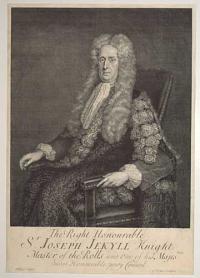
The Right Honourable S.r Joseph Jekyll Knight Master of the Rolls, and one of his Majest-ties most Horourable Privy Council.
M.Dahl pinxit. G.Vertue sculpsit. 1730.
[London, 1730.]
Engraving. Sheet 390 x 285mm (15¼ x 11¼"). Trimmed to plate.
Seated portrait of Sir Joseph Jekyll (1663-1738), wearing judicial wig and robe. A Whig politician, he sat in the House of Commons for 40 years, 1697-1738. He became Master of the Rolls in 1717.
[Ref: 57411] £230.00
(£276.00 incl.VAT)
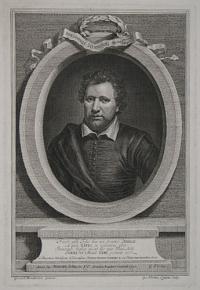
Benjaminus Johnson. Obijt Anno. Dom 1687. Aetat 63. Fronti nulla Fides huic non dicatur: Apelle A tanto Vates, en redivivus ades. Immortale duplez micat hic opus: Illius Arte Forma, tua a Penna Fama, perennis erit. E Pinacotheca Nobilissimi & & Honoratissimi Joannis Domini Sommers &c. Cui Tabulam hanc humillimè dicat.
Gerard Honthorst pinxit. Geo: Vertue, Londini Sculp.
Amico suo Mauritio Johnson I.C. Artium Amatori redicat 1730. G. Vertue.
Engraving. Plate 372 x 252mm. Sheet 451 x 330mm. Fine.
Benjamin Johnson (1572-1637) was an English Renaissance dramatist, poet and actor. A contemporary of William Shakespeare, he is best known for his satirical plays, particularly Volpone, The Alchemist, and Bartholomew Fair, which are considered his best, and his lyric poems. A man of vast reading and a seemingly insatiable appetite for controversy, Jonson had an unparalleled breadth of influence on Jacobean and Caroline playwrights and poets.
[Ref: 12633] £140.00
(£168.00 incl.VAT)
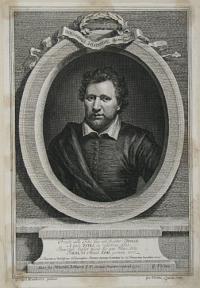
Benjaminus Johnson. Obijt Anno} Dom. 1637. aetat. 63. Fronti nulla Fides huic non dicatur: Apelle A tanto, Vates, èn redivivus ades. Immortale duplex micat hic opus: Illius Arte Forma, tuâ a Pennâ Fama, perennis erit. E Pinacotheca Nobilissimi & Honoratissimi Joannis Domini Sommers &c. Cui Tabulam hanc humillimè dicat. Amico suo Mauritio Johnson I.C. Artium Amatori redicat 1730. G. Vertue.
Gerard Honthorst pinxit. Geo: Vertue, Londini Sculp.
[n.d. c.1730.]
Engraving. Mounted on an album page. Image 369 x 253mm. 14½ x 10". Trimmed and laid on sheet. Some glue staining to the corners.
Benjamin Johnson (1572-1637) was an English Renaissance dramatist, poet and actor. A contemporary of William Shakespeare, he is best known for his satirical plays, particularly Volpone, The Alchemist, and Bartholomew Fair, which are considered his best, and his lyric poems. A man of vast reading and a seemingly insatiable appetite for controversy, Jonson had an unparalleled breadth of influence on Jacobean and Caroline playwrights and poets. From the Belton House Collection assembled in the 18th Century by the Rt. Hon. John Ld. Brownlow, Baron Charleville, & Viscount Tyrconnel in the Kingdom of Ireland. Ex: Collection of The Hon. C. Lenno
[Ref: 12917] £290.00
(£348.00 incl.VAT)
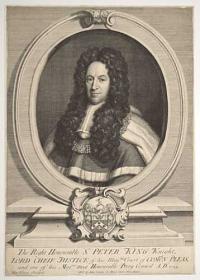
The Right Honourable S.r Peter King Knight, Lord Cheif Justice of his Maj.ties Court of Comon Pleas, and one of his Maj.ties most Honourable Privy Council A.o D.ni 1724.
Geo: Vertue Sculpsit.
Sold by Iohn Carson in Mitre Court Fleet Street.
Copper engraving. Sheet 370 x 260mm (14½ x 10½"). Trimmed to plate.
Peter King (1669-1734), 1st Baron King PC, FRS, lawyer and politician. From 1714 to 1725 he was chief justice of the common pleas and was appointed speaker of the House of Lords, after being raised to peerage. In the same year he was made Lord Chancellor, until he was forced to resign in 1733 following a paralytic stroke. Alexander 412, state i of ii. See 17131 for 2nd state.
[Ref: 56142] £220.00
(£264.00 incl.VAT)
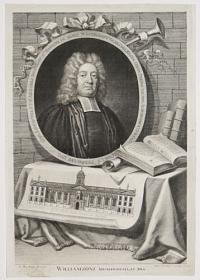
Guil. Lancaster S.T.P. Archidiac. Middlesex. S.ti Martini in Agris Wesmonast. Vicar. Coll. Regin. Oxon. Praepos. Nec Non Acad. Eiusdem Vice Can. Obijt. 4.to Februarii 1716. Williamsoni Munificientia, et Sua.
T. Murray Pinxit. Geo. Vertue sculpsit. 1718.
Engraving. Plate 387 x 266mm. 15¼ x 10½". Repaired tear into lower edge, crease.
Portrait of William Lancaster, half-length to right, facing front; wearing a wig and ecclesiastical robes and bands; in an oval frame with ribbon and trumpet on top, placed on a draped table, on which lie two upright books and an open book, scroll of paper, and a plan of the façade of a building lettered "Coll. Regin. Oxon conspectus Australis." William Lancaster (1650-1717), the English clergyman and academic who was provost of Queen's College, Oxford; rector of St Martin's-in-the-Fields, and archdeacon of Middlesex. NPG: D31521. Alexander: 260.
[Ref: 27270] £130.00
(£156.00 incl.VAT)
![[Montague Bertie, 2nd Earl of Lindsay, and Robert Dormer, 1st Earl of Carnarvon]](img-thumbnail/jpegs/47292.jpg)
[Montague Bertie, 2nd Earl of Lindsay, and Robert Dormer, 1st Earl of Carnarvon] This Loyal Earl was a Person of very Noble Extraction and great Honour [...]
Vandike pinx.t G. Vertue Sculp.
Publish'd according to Act of Parliam.t 1757 Printed for John Ryall & Rob.t Withy at Hogarths head, Fleet Street
Engraving, platemark 330 x 225mm (13 x 8¾"). Stained on left. Small margins.
One of nine double portraits of Loyalists which George Vertue engraved between 1731 and 1735, with long engraved accounts of their careers from Clarendon below. They were issued as a set, along with a portrait of Charles I, in 1735 This is a reprint of one of those plates, from 1757 Alexander 650
[Ref: 47292] £35.00
(£42.00 incl.VAT)
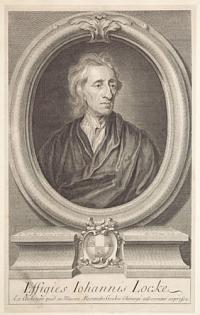
Effigies Iohannis Locke. Ex Archetypo, quod in Musæo Alexandri Geekie Chirurgi adservatur espressa.
G. Kneller Eques pinxit 1697. Geo. Vertue Sculp; 1713.
Engraving. Sheet 250 x 160mm (9¾ x 6¼"). Trimmed within plate, mounted in album paper.
The Enlightenment philosopher and physician John Locke (1632-1704), after the painting by Sir Godrey Kneller, once in the Walpole Collection at Houghton, now in the Hermitage Museum.
[Ref: 52844] £95.00
(£114.00 incl.VAT)
![Londinium Antiqua. This Plan shews the ancient extent of the famous cities of London and Westminster as it was near the begining of the Reign of Queen Elizabeth [...]](img-thumbnail/jpegs/35662.jpg)
Londinium Antiqua. This Plan shews the ancient extent of the famous cities of London and Westminster as it was near the begining of the Reign of Queen Elizabeth [...]
Vertue, Soc. Antiq. London excudit 1737.
Engraving on pewter, two sheets (of eight) conjoined, total 355 x 940mm. Repairs to folds. Ink stamps of the Paul Mellon Collection on reverse.
The bottom left corner of a map of Tudor London, engraved on pewter by George Vertue from a comtemporary woodcut in the possession of Sir Hans Sloane. The strip here shows Westminster, Whitehall, Lambeth Palace and Charing Cross, the buildings south of the Strand and Fleet Street, to St Paul's Cathedral and Barnard's Castle. Under the title is a list of buildings not present, as a guide to dating the map. Three examples of an anonymous woodcut map of London c.1570 exist, all now in institutions. Vertue, an enthusiastic member of the Society of Antiquaries, researched the map and attributed it to Ralph Agas (c.1540-1621), solely on the basis of a letter in which Agas spoke of his intentions of making such a plan. The style is much the same as Braun & Hogenberg, with the buildings shown in profile, and many of the details are shared. However on this plan St Paul's Cathedral is without the spire hit by lighting and destroyed in 1561 (not shown here as the building runs off the top of the present sheet). Howgego: Printed Maps of London 8, and the introduction pp.7 - 8.
[Ref: 35662] £1,800.00
![[The Chapel of St Thomas on the Bridge] Inside South View of the Under Chappel from East to West,](img-thumbnail/jpegs/61252.jpg)
[The Chapel of St Thomas on the Bridge] Inside South View of the Under Chappel from East to West, representing the manner and form of this rare piece of Ancient Architecture, thus drawn and transmitted to posterity, by G. V., Antiquary, 1744.
[George Vertue.]
[Published and sold by G. Vertue, in Brownlow Street, Drury-Lane, 1747.]
Etching with engraving. Sheet 230 x 460 (9 x 18"). Trimmed from a larger sheet, to printed borders on three sides, into image at top.
An interior view of the Lower Chapel of St Thomas on the Bridge, a bridge chapel built near the centre of London Bridge, with windows looking out over the river. Founded c.1205, it was in use as a chapel until 1548, during the Reformation, when it converted to a residence and warehouse. The Upper Chapel was removed in 1747 (when this print was produced); the lower chapel survived until the whole bridge was demolished in 1832. This print originally had a view of the Upper Chapel above. Both views were drawn by Vertue, based on a survey by the architect Nicholas Hawksmoor (1661-1736), published in a pamphlet called A Short Historical Account of London Bridge in 1736.
[Ref: 61252] £120.00
(£144.00 incl.VAT)
![[John Evelyn's London plan, drawn after the Fire of London 1666] [&] London Redivivum / Presented by me to his Majesty, a Week after the Conflagration, together with a Discourse now in the Paper Office. JE [John Evelyn]. Another Projection JE. [...]](img-thumbnail/jpegs/45273.jpg)
[John Evelyn's London plan, drawn after the Fire of London 1666] [&] London Redivivum / Presented by me to his Majesty, a Week after the Conflagration, together with a Discourse now in the Paper Office. JE [John Evelyn]. Another Projection JE. [...] [London plans by John Evelyn and Sir Christopher Wren, drawn after the Fire of London 1666] [&] A Plan of London [...] Described by J. Evelyn Esq. F.R.S. A Plan of the City of London, after the Great Fire in the Year of our Lord 1666, according to the design and proposal of S.r Christopher Wren K.t.
[Engraved by George Vertue.]
Sumptibus Societat. Antiquar. London. 1748.
Set of 4 engravings on two sheets, platemark 480 x 360mm (19 x 14"). 1st plate very large margins, 2nd plate cut nearly to platemark .
Plans for the rebuilding of London after the Great Fire of 1666 by the diarist and writer John Evelyn (1620 - 1706). Attempting to raise morale after the disaster, Charles II encouraged the belief that London could be rebuilt to one plan. Plans simplifying London's complex network of roads were accordingly submitted by Evelyn, Sir Christopher Wren, Robert Hooke, Valentine Knight and Richard Newcourt, among others. However the rebuilding could not be put on hold as while ownership and other problems were worked out. Thus the city's roads remained much as they were before the fire, albeit with measures taken to improve safety. Alexander 936; for this plate offered with another sheet of plans by Evelyn and Wren see ref. 38396. Alexander 937; for this plate offered with another sheet of plans by Evelyn see ref. 38396. Proven
[Ref: 45273] £480.00
view all images for this item

London Redivivum. Presented by me to his Majesty, a Week after the Conflagration, together with a Discourse now in the Paper Office. JE [John Evelyn]. Another Projection JE. [&] A Plan of London... Described by J. Evelyn Esq. F.R.S. A Plan of the City of London, after the Great Fire in the Year of our Lord 1666, according to the design and proposal of S.r Christopher Wren K.t.
[Engraved by George Vertue.]
Sumptibus Societat. Antiquar. London. 1748.
Four maps on two engraved sheets. Each 480 x 360mm (19 x 14"). Large margins.
Four plans for the rebuilding of London after the Great Fire of 1666, three by John Evelyn (1620 - 1706) and the last by Sir Christopher Wren. Attempting to raise morale Charles II encouraged the belief that London could be rebuilt to one plan, and plans were submitted by Eveyln, Wren, Robert Hooke, Valentine Knight and Richard Newcourt, among others. However the rebuilding could not be put on hold as while ownership and other problems were worked out. Thus the city's roads reappeared in the same pattern, but wider and with an eye on safety.
[Ref: 38396] £360.00
view all images for this item
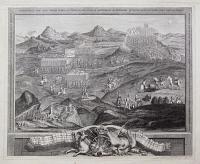
The Battle-Array of Carberry-hill near Edinburgh with the Surrender of Mary Queen of Scots to the Confederate Lords of Scotland, and the Escape of Earl Bothwell, 1567.
Geo: Vertue delin & Sculp 1742
Engraving, platemark 460 x 575mm (18 x 22½"), with very large margins. Repairs in margins.
The surrender of Mary, Queen of Scots at Carberry Hill in Haddingtonshire in 1567. Engraved by George Vertue and issued in the first part of his 'Historical Portraitures', four large historical prints, in 1743. These were followed by further parts, amounting to nine prints in total, which were reissued in 1751 and later. Alexander 856; for the complete set of 'Historical Portraitures' see ref.39870.
[Ref: 47405] £360.00

Conyers Middleton. Principal Librarian to the University of Cambridge.
Echardt pinx.
[n.d. c.1750.]
Fine, uncut copper engraving. Plate 218 x 154mm. 8½ x 6".
Conyers Middleton (1683-1750) was an English clergyman. Born and educated in Yorkshire, he went on to graduate from Trinity College Cambridge, taking holy orders later on, and in 1706 he obtained a fellowship, which he resigned upon entering into an advantageous marriage. He wrote several trenchant pamphlets. NPG: D14055.
[Ref: 14975] £75.00
(£90.00 incl.VAT)
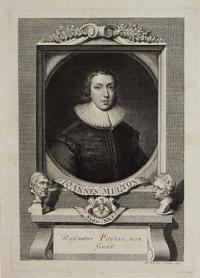
Ionnnes Milton. Ætatis XXI. Nascuntur Poetae, non fiunt.
G: Vertue sculp. 1731.
Engraving. Plate: 240 x 170mm (9½ x 6¾'') large margins.
A portrait of poet John Milton (1608-1674) aged 21, set in decorative frame with busts of Virgil and Homer below. Alexander 624.
[Ref: 48656] £140.00
(£168.00 incl.VAT)

Apud Wellow prope Aquas Solis in agro Somersetensi repertum. Sumptibus Societatis Antiquariae Londini aeri incisum Ao.MDCCXXXVIII.
[George Vertue.]
[Published the Society of Antiquaries, 1783.]
Copper Engraving. 355 x 446mm. 14 x 17½". Vertical crease through centre; two wormholes.
A plate, from a set of three, showing Roman mosaic pavements found at Wellow, Somerset. Ex Collection: Norman Blackburn.
[Ref: 19810] £130.00
(£156.00 incl.VAT)

Hoh! Maister John Murray of Sacomb. / The Works of Old Time to collect was his Pride, / Till Oblivion dreaded his Car: / Regardless of Friends intestate he dy'd, / So the Rooks & the Crows were his Heir. G.V.
G. Verue ad vivum delin. 17387, et sculp. 1752.
Engraving. 170 x 115mm (6¾ x 4½"). Narrow margins.
John Murray (1670-1748), antiquary and book collector who scoured the country for rare titles by English authors, often on commission. He was a friend of Thomas Hearne, often appearing in his diaries; one of the books Murray leans on is 'T Hearne Vol III (the others 'Sessions Papers' & 'Tryals of Witches'). Alexander 970.
[Ref: 56635] £130.00
(£156.00 incl.VAT)
![[Netherlands] Franciscus Gomarus.](img-thumbnail/jpegs/31125.jpg)
[Netherlands] Franciscus Gomarus.
G. Vertue sculp.
[1721]
Engraving, sheet 310 x 180mm (12¼ x 7"). Trimmed inside platemark.
Francis Gomar (1563-1641), Calvinist theologian. One of twelve portraits engraved by George Vertue in 1721 for Geeraert Brandt's 'History of the Reformation'. Alexander 340
[Ref: 31125] £65.00
(£78.00 incl.VAT)

Sir William Noy Attorny General.
Corn: Iohnson pinx. 13. 'Vertue' [faded m.s. lower right]
[1713.]
Engraving with large margins. Plate 171 x 95mm (6¾ x 3¾").
William Noy (1577-1634) the noted British jurist. In 1631 he was created Attorney-general. Plate from Edward Ward's 'History of the Grand Rebellion' (3 vols, 1713), the list of plates to which gives George Vertue as engraver of unsigned prints such as this. NPG: D26967; O'D 1 (as printmaker anonymous); Alexander 29
[Ref: 29692] £45.00
(£54.00 incl.VAT)
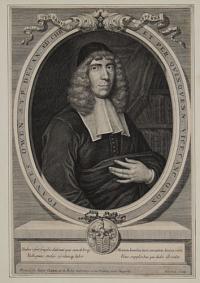
Ioannes Owen S.T.P. Dec. An. Aed. Chr. Et Per Quiquenn. Vice Canc. Oxon. Umbra refert fragiles, dederunt quas cura dotorqs, Mentem humitem, sacri servantem limina veri, Relliquias, studijs assiduusqs labor, Votis supplicibus, qui dedit ille videt.
Vertue Sculp.
Printed for Iohn Clark, at the Bible and Crown in the Poultry, near Cheapside.
Engraving. 272 x 190mm. 10¾ x 7½".
John Owen (1616-1683), Puritan divine, in an oval frame on a pedestal, wearing skull-cap, bands and gown; curtain and bookshelves in the background. Owen was dean of Christ Church, Oxford and vice-chancellor of Oxford under Cromwell. Coat of arms below. Frontispiece to 'The Works of the late [...] John Owen, D.D.' (William and Joseph Marshall et al ed, London: 1721); after White. Alexander: 314. See Ref: 13860 for proof before title.
[Ref: 24748] £95.00
(£114.00 incl.VAT)

The Oxford Almanack for the Year of the our Lord God MDCCXXVIII. Being Bissextile or Leap Year.
G. Vertue Sculp.
[n.d. c.1728.]
Etching and engraving. Plate 484 x 442mm (19 x 17½"). Tax stamp top left corner. Staining; nicks and tears to margin edges; tear into plate upper right corner.
A view of Hawksmoor's 1715 design for rebuilding All Souls College; in the foreground, Henry V sitting on the left, receiving a petition for its foundation from Archbishop Chichele, with figures on the right blowing trumpets and holding up standards and crests. See Helen Mary Petter, 'The Oxford Almanacks' (Oxford 1974), p. 56-57; Alexander. There are proofs without the Officers of the University in Worcester College Library and BM P&D (1880,d.9) and a red chalk and wash drawing for the engraving in Worcester College Library (Colvin, catalogue no. 11). The Oxford Almanack is an annual almanac published since 1674. The stamp duty was payable to the compiler of the almanac, set at 1 shilling and threepence per year covered by Act of Parliament 55 Geo. III c. 185. The same act set the penalty for issuing an unstamped almanac as three months' imprisonment. Alexander (2008): 536.
[Ref: 52468] £320.00
![[The Oxford Almanack for 1742, showing Balliol College]](img-thumbnail/jpegs/43930.jpg)
[The Oxford Almanack for 1742, showing Balliol College]
G Vertue sculp. [1740/41]
Etching with engraving, sheet 355 x 430mm (14 x 17"). Trimmed, losing almanack text; glued to backing sheet.
View of a scheme to rebuild Balliol College; this was started in 1738, but was not continued after 1743. The lower half of the image includes eighteen identifiable figures associated with the college, including Bishop John Robinson. The engraver and antiquary George Vertue (1684-1756) succeeded Michael Burghers as engraver to Oxford University in 1727, a post which included the responsibility of engraving almanacks such as this. Alexander 837
[Ref: 43930] £240.00
(£288.00 incl.VAT)

The Oxford Almanack for the Year of the our Lord God MDCCXLII.
G. Vertue Sculp.
[n.d. c.1742.]
Etching and engraving. Plate 501 x 458mm (19¾ x 18"). Tax stamp top left corner.
A view of Balliol College, from the south; below, in a frame, the founder John de Balliol and his wife Devorguilla sitting in a neo-classical alcove with Sir Phillip Somerville and Sir William Felton to left, Lady Periham and Peter Blundell to right; in front, to left, are Bishop Gray of Ely, holding an elevation of the library which he built, with Sir Thomas Wandy; in the centre is Bishop Bell of Worcester watching cherubs measure a plan of the old front which he had built; to right are Dr Compton and Dr Robinson, Bishops of London and Dr Mander, with drawings of churches; behind them are Bishop Warner of Rochester, Dr Snell and Dr Busby; at the back are Humphrey, Duke of Gloucester, Archbishop Neville of York and Wycliffe; in niches to either side are figures of Divinity and Mathematics. See Helen Mary Petter, 'The Oxford Almanacks' (Oxford 1974), p. 62-63; Alexander. There are two plates, signed 'G Vertue Sculp.' and 'G Vertue Scul'; proofs with the heading only; a drawing in the Ashmolean on two sheets; a silk almanac with a red border at the OUP, London. The scheme for rebuilding the college was begun in 1738 and ran until 1743; only the East range and three bays of the south front were built. Petter suggests that the architect may have been the mason in charge of new building, William Townesend. Alexander adds that if the illustration of the design in the almanac was intended to raise funds for the project, the college must have been disappointed. The Oxford Almanack is an annual almanac published since 1674. The stamp duty was payable to the compiler of the almanac, set at 1 shilling and threepence per year covered by Act of Parliament 55 Geo. III c. 185. The same act set the penalty for issuing an unstamped almanac as three months' imprisonment. Alexander (2008): 837.
[Ref: 52480] £320.00

The Oxford Almanack for the Year of the our Lord God MDCCXXXIX.
Vertue Sculp.
[n.d. c.1739.]
Etching and engraving. Plate 509 x 451mm (20 x 17¾"). Tax stamp top left corner. Staining and creasing.
A view of Exeter College; in the foreground, a low wall decorated with crests and busts, of Walter Stapledon, the founder, Edmund Stafford, William Petre, Charles I, Dr. George Hakewill, who built the chapel and John Acland, who built the hall, with two cherubs holding a cameo labelled 'Eliz. Sheire [or Shepre]' and scroll of crests in front of it; in the centre stand, Dr Marsh, who rebuilt one side of the quadrangle, with a plan of the building, with Dr Bull; to right are eminent lawyers, students of the college, the Earl of Shaftesbury, Sir George Treby, Judge Pollexfen and Sir John Maynard. See Helen Mary Petter, 'The Oxford Almanacks' (Oxford 1974), p. 65-66. Both surviving plates are signed by Vertue. Mr Green the painter was paid £4.4s.0d. in 1737-8 for the drawing. There are proofs with incomplete Regal table and list of Officers in BM P&D (1880,d.9) and at the OUP, London; also one with the picture only. There is an engraving of the façade of the College in elevation by Burghers dated 1709, from which they may have been taken and the façade was illustrated in W. Williams, 'Oxonia Depicta', Pl. xvi, 1733. The Oxford Almanack is an annual almanac published since 1674. The stamp duty was payable to the compiler of the almanac, set at 1 shilling and threepence per year covered by Act of Parliament 55 Geo. III c. 185. The same act set the penalty for issuing an unstamped almanac as three months' imprisonment. Alexander (2008): 802.
[Ref: 52477] £320.00
![[The Oxford Almanack for 1743, showing Lincoln College]](img-thumbnail/jpegs/43931.jpg)
[The Oxford Almanack for 1743, showing Lincoln College]
G Vertue sculp. [1742]
Etching with engraving, sheet 365 x 435mm (14½ x 17"). Trimmed, losing almanack text; glued to backing sheet.
View of Lincoln Collage, with two groups of figures above. On the extreme left is Richard Fleming, one of the founders, with behind him Thomas Beckington, John Forest, William Finderne and John Bucktot. Another founder, Thomas Rotherham, is amongst the group of the right. The engraver and antiquary George Vertue (1684-1756) succeeded Michael Burghers as engraver to Oxford University in 1727, a post which included the responsibility of engraving almanacks such as this. Alexander 852
[Ref: 43931] £220.00
(£264.00 incl.VAT)
![[Merton College] The Oxford Almanack For the Year of Our Lord God MDCCXXXVII.](img-thumbnail/jpegs/43929.jpg)
[Merton College] The Oxford Almanack For the Year of Our Lord God MDCCXXXVII.
G Vertue sculp.
[1736]
Etching with engraving, sheet 490 x 440mm (19¼ x 17¼"). Glued to backing sheet; trimmed; fold on left.
A view of Merton College with a group of benefactors in the foreground, including Walter de Merton (d.1277) in the centre and to his left William Rede (d.1385), Bishop of Chichester and builder of the college library. The engraver and antiquary George Vertue (1684-1756) succeeded Michael Burghers as engraver to Oxford University in 1727, a post which included the responsibility of engraving almanacks such as this. Alexander 752
[Ref: 43929] £240.00
(£288.00 incl.VAT)
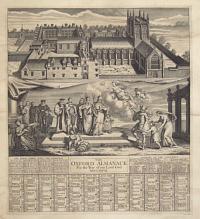
The Oxford Almanack for the Year of the our Lord God MDCCXXXVII.
Vertue Sculp.
[n.d. c.1737.]
Etching and engravin. Plate 501 x 451mm (19¾ x 17¾"). Tax stamp top left corner. Staining and creasing.
A view of Merton College. The Oxford Almanack is an annual almanac published since 1674. The stamp duty was payable to the compiler of the almanac, set at 1 shilling and threepence per year covered by Act of Parliament 55 Geo. III c. 185. The same act set the penalty for issuing an unstamped almanac as three months' imprisonment.
[Ref: 52475] £320.00
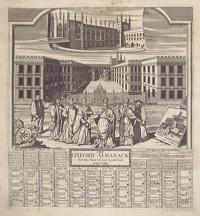
The Oxford Almanack for the Year of the our Lord God MDCCXXIX.
G. Vertue Sculp.
[n.d. c.1729.]
Etching and engraving. Plate 480 x 450mm (19 x 17¾"). Tax stamp top left corner. Staining; nicks and tears to margin edges.
A view of New College, from the garden with a view of Chapel, Hall and Winchester College. The Oxford Almanack is an annual almanac published since 1674. The stamp duty was payable to the compiler of the almanac, set at 1 shilling and threepence per year covered by Act of Parliament 55 Geo. III c. 185. The same act set the penalty for issuing an unstamped almanac as three months' imprisonment.
[Ref: 52469] £320.00
![[The Oxford Almanack for 1750, showing New Inn Hall]](img-thumbnail/jpegs/43932.jpg)
[The Oxford Almanack for 1750, showing New Inn Hall]
G Vertue sculp. [1749]
Etching with engraving, sheet 365 x 450mm (14½ x 17½"). Trimmed, losing almanack text; glued to backing sheet; fold on left.
Small view of New Inn Hall within elaborate design dividing image into three rococo compartments, with three groups of standing figures. The engraver and antiquary George Vertue (1684-1756) succeeded Michael Burghers as engraver to Oxford University in 1727, a post which included the responsibility of engraving almanacks such as this. Alexander 950
[Ref: 43932] £220.00
(£264.00 incl.VAT)
![[Oriel College] The Oxford Almanack For the Year of Our Lord God MDCCXXVI](img-thumbnail/jpegs/41666.jpg)
[Oriel College] The Oxford Almanack For the Year of Our Lord God MDCCXXVI being Bisextile or Leap Year.
G Vertue sculp.
[n.d., c.1734.]
Etching with engraving, PRINTED ON SILK. Printed area 500 x 440mm (19¾ x 17¼"), with wide margins. Framed. Unexamined out of frame. Damage to right borders.
A view of Oriel College with the Robinson building, erected in 1720 and the Carter building, 1729. In the left foreground Adam de Brome, chancellor of Durham and founder of Oriel, receives the charter from Edward II; on the right a chancellor and bishops, including Bishop Robinson and Provost George Carter, examine a charter. In the roundels above the image are Queen Anne delivering a grant of Prebend to Bishop Robinson in 1712; to right, an allegory of the Treaty of Utrecht, negotiated by Robinson in 1713.
[Ref: 41666] £950.00

The Oxford Almanack for the Year of the our Lord God MDCCXXXVI being Bissextile or Leap Year.
G: Vertue Sculp.
[n.d. c.1736.]
Etching and engraving, partly stamped at top left corner. Plate 501 x 451mm (19¾ x 17¾") with very wide margins. Central crease.
View of Oriel College with the Robinson building, erected in 1720 and the Carter building, 1729; in the foreground, Adam de Brome, chancellor of Durham and founder of the college, receives the charter from Edward II, who sits under a canopy stretched over pillars carved into male figures, while benefactors to right, among them a chancellor and Bishops, including Bishop Robinson and Provost George Carter, examine a charter. See Helen Mary Petter, 'The Oxford Almanacks' (Oxford 1974), p. 60; Alexander. Both plates were engraved by Vertue. In the roundels above the image are Queen Anne delivering a grant of Prebend to Bishop Robinson, in 1712; to right, an allegory of the Treaty of Utrecht, negotiated by Robinson in 1713. The Oxford Almanack is an annual almanac published since 1674. The stamp duty was payable to the compiler of the almanac, set at 1 shilling and threepence per year covered by Act of Parliament 55 Geo. III c. 185. The same act set the penalty for issuing an unstamped almanac as three months' imprisonment. Alexander (2008): 719.
[Ref: 52474] £320.00

The Oxford Almanack for the Year of the our Lord God MDCCXLIV. Being Bissextile or Leap Year.
G. Vertue Sculp.
[n.d. c.1744; but later?]
Etching and engraving. Plate 510 x 463mm (20 x 18¼") with very wide margins.
View of Pembroke College, below a scene showing James I granting the charter to Lord Pembroke, watched by Thomas Tesdal and Richard Wightwick, the founders, with John Bennett, 1st Lord Ossulstone and John Hall to left, the latter holding a drawing of the Master's Lodgings, which he had built in 1695 and to right, Francis Rous, George Townsend, Juliana Stafford and Dame Holford; in pictures on the wall behind are, to left, Charles I giving the college patronage of St Aldate's church and founding a fellowship for natives of Jersey and Guernsey and to right, Queen Ann granting Chancellor Harcourt a charter for endowing the Master with a Prebend of Gloucester. See Helen Mary Petter, 'The Oxford Almanacks' (Oxford 1974), p. 63; Alexander. Both surviving plates are signed by Vertue. There is a proof without the calendar in the Ashmolean Museum and a drawing signed 'W. Greene delin.', in which the figures differ to those in the engraving. Greene was paid 5 guineas for the desihn in 1742-3. The buildings are similar to Plate lvi in W. William s 'Oxonia Depicta' (1733). The Oxford Almanack is an annual almanac published since 1674. The stamp duty was payable to the compiler of the almanac, set at 1 shilling and threepence per year covered by Act of Parliament 55 Geo. III c. 185. The same act set the penalty for issuing an unstamped almanac as three months' imprisonment. Alexander (2008): 864.
[Ref: 52481] £320.00
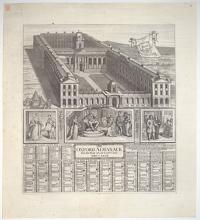
The Oxford Almanack for the Year of the our Lord God MDCCXXVII.
G. Vertue Sculp.
[n.d. c.1727.]
Etching and engraving. Plate 490 x 444mm (19¼ x 17½"). Stamped at top left corner, with very wide margins. Creasing.
View of Queen's College, showing two quadrangles and Hawksmoor's original design for the cupola, above a frame divided into three; to left, Queen Philippa and the founder, Robert Eglesfield; in the centre, Queen Philippa and Edward III, enthroned, with Eglesfield presenting the plan; to right, Sir Joseph Williamson and Dr Lancaster. See Helen Mary Petter, 'The Oxford Almanacks' (Oxford 1974), p. 56; Alexander. Both surviving plates are signed by Vertue. 'Vertue and others' were paid £76 7s. 0d. for 'engraving etc. the Almanack'; Alexander suggests that Vertue sub-contracted some of the work, probably the calendar, which had been engraved by William Hullet in the previous two years. He adds that although Vertue places this under 1727, it was presumably engraved in 1726. The Oxford Almanack is an annual almanac published since 1674. The stamp duty was payable to the compiler of the almanac, set at 1 shilling and threepence per year covered by Act of Parliament 55 Geo. III c. 185. The same act set the penalty for issuing an unstamped almanac as three months' imprisonment. Alexander (2008): 489.
[Ref: 52467] £320.00
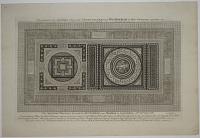
Pavimentum hoc Tessellatum Elegantiss: Stunsfeldiae prope Woodstochiam in Agro Oxoniensi repertum est. This Tessellated Pavement, discover'd at Stunsfield near Woodstock in Oxfordshire A.no D.ni MDCCXII. A most Exquisite Work of the Antient Romans, composed with great variety of Small Tesserae of Beautiful Colours & Summetry, esteem'd to be the most Elegant Piece of Antiquity of the Kind found in Great Britain. When first open'd it was seen by Multitudes of Curious Persons, and some Learned Antiquaries have employ'd their Skill to trace out its Original Use. Now only remains this Shade, preserv'd first Care of Tho. Hearne M.A. of Oxford, and lastly by G. Vertue Member of the Society of Antiquaries London. 35 feet by 20.
[T. Hearne. G. Vertue.]
[1712.]
Copper engraving. Plate 292 x 470mm. 11½ x 18½".
A drawing of the a tessellated pavement found at the Roman Villa at Stonesfield, Oxfordshire in 1712. Ex Collection: Norman Blackburn.
[Ref: 19816] £180.00
(£216.00 incl.VAT)

The Oxford Almanack for the Year of the our Lord God MDCCXXXIII.
[G. Vertue Sculp.]
[n.d. c.1733.]
Etching and engraving. Plate 507 x 451mm (20 x 17¾"). Tax stamp top left corner. Some spotting.
A view of St John's College, on a scroll against a landscape background; in three frames below are Archbishop Laud, to left, praying, with a four-headed demon in front of him; in the centre, Sir Thomas White, the founder, with figures of charity and Aesculapius; to right, Bishop Juxon leading Charles I to the scaffold. See Helen Mary Petter, 'The Oxford Almanacks' (Oxford 1974), p. 59. Mr Green was paid £4.4s.0d. for the design and Mr Debosc was paid £52.10s.0d. for engraving two plates. This was probably Claude Du Bosc, who also engraved a plate for 1720. The buildings are taken from David Loggan, 'Oxonia Illustrata' (1675). The Oxford Almanack is an annual almanac published since 1674. The stamp duty was payable to the compiler of the almanac, set at 1 shilling and threepence per year covered by Act of Parliament 55 Geo. III c. 185. The same act set the penalty for issuing an unstamped almanac as three months' imprisonment.
[Ref: 52472] £320.00

The Oxford Almanack for the Year of the our Lord God MDCCXXXIV.
G. Vertue Sculp.
[n.d. c.1734.]
Etching and engraving. Plate 501 x 451mm (19¾ x 17¾"). Tax stamp top left corner. Some spotting and soiling.
View of the Canterbury Quad of St John's College, with a statue in a niche above an arched entrance in the far side; with Dr Sherard on the left, holding a plan of the Botanical Gardens, kneeling beside Oxonia who sits under a neo-classical porch, receiving a procession of officials, headed by Archbishop Laud, who had the quadrangle built. See Helen Mary Petter, 'The Oxford Almanacks' (Oxford 1974), p. 59; Alexander. The Canterbury Quadrangle was built by Archbishop Laud in 1631-36. Vertue records in 1729 that he 'drew St John's Coll. quadrangle, Collonade, and front of of the 2 great arches designed by Inigo Jones (not certain)'. Both plates were engraved by Vertue. Alexander notes that this is one of the few Almanacks designed not in Oxford, but by Vertue himself, who often engraved the architectural elements from drawings made in Oxford, often after existing engravings. The Oxford Almanack is an annual almanac published since 1674. The stamp duty was payable to the compiler of the almanac, set at 1 shilling and threepence per year covered by Act of Parliament 55 Geo. III c. 185. The same act set the penalty for issuing an unstamped almanac as three months' imprisonment. Alexander (2008): 625.
[Ref: 52473] £320.00

The Oxford Almanack for the Year of the our Lord God MDCCXXXII. Being Bissextile or Leap Year.
[G. Vertue Sculp.]
[n.d. c.1732.]
Etching and engraving. Plate 495 x 458mm (19½ x 18"). Tax stamp top left corner. Staining; creasing.
Trinity College, shown in the background with figures in the foreground, including the founder Sr Thomas Pope, holding a view of the college to left, Dr Bathurst in the centre, refusing the mitre which is offered by a cherub, with a view of a neo-classical façade and another showing the central section of the building shown, on the ground nearby and other figures to right, including Adams, Bishop of Limerick and Wright, Bishop of Litchfield, fellows of the college. The Oxford Almanack is an annual almanac published since 1674. The stamp duty was payable to the compiler of the almanac, set at 1 shilling and threepence per year covered by Act of Parliament 55 Geo. III c. 185. The same act set the penalty for issuing an unstamped almanac as three months' imprisonment.
[Ref: 52471] £320.00

The Oxford Almanack for the Year of the our Lord God MDCCXXXVIII.
G. Vertue Sculp.
[n.d. c.1738.]
Etching and engraving. Plate 506 x 451mm (20 x 17¾"), very large margins. Stamped at top left corner. Central crease.
A view of Wadham College, according to designs for its rebuilding; in the foreground, James I enthroned to left with the founders Nicholas and Dorothy Wadham beside him and an allegorical female figure of Learning, with John Wilkins, warden and Bishop of Chester in the centre, holding drawings of Wadham and Gresham colleges, Thomas Sprat, writing his history of the Royal Society, the astronomer Seth Ward and former students Christopher Wren, with views of the Sheldonian Theatre and St. Paul's and Admiral Robert Blake, indicating a picture of a naval engagement; behind these figures is another group, including Philip Bisse and Humphrey Hody, professor of Greek. See Helen Mary Petter, 'The Oxford Almanacks' (Oxford 1974), p. 65-66. Both surviving plates are signed by Vertue. Me green the painter was paid £4.4s.0d. in 1745-6 for the drawing. The front and flanking buildings are taken from an engraving signed 'MBurghers delin. et sculp.', the rest is taken from Loggan, 'Oxonia Illustrata' in 1675. The Oxford Almanack is an annual almanac published since 1674. The stamp duty was payable to the compiler of the almanac, set at 1 shilling and threepence per year covered by Act of Parliament 55 Geo. III c. 185. The same act set the penalty for issuing an unstamped almanac as three months' imprisonment. Alexander (2008): 786.
[Ref: 52476] £320.00

The Oxford Almanack for the Year of the our Lord God MDCCXLI.
G. Vertue Sculp.
[n.d. c.1741.]
Etching and engraving. Plate 501 x 458mm (19¾ x 18"). Tax stamp top left corner.
A view of Worcester College, according to the 18th century design, of which the south side was never built; below, a cartouche showing Charity kneeling before the founder Sir Thomas Cookes, standing next to Bishop Lloyd of Worcester, followed by figures of Divinity, Law, Physick and the Sciences; to right, Dr Clarke stands holding a plan of the library, with benefactors Margaret Alcorne and Sarah Eaton. See Helen Mary Petter, 'The Oxford Almanacks' (Oxford 1974), p. 62. Both surviving plates are signed by Vertue; the perspective is taken from the engraving by W. Williams, 'Oxonia Depicta', 1733, Pl. lviii. The Oxford Almanack is an annual almanac published since 1674. The stamp duty was payable to the compiler of the almanac, set at 1 shilling and threepence per year covered by Act of Parliament 55 Geo. III c. 185. The same act set the penalty for issuing an unstamped almanac as three months' imprisonment. Alexander (2008): 826.
[Ref: 52479] £320.00

The Right Hon.ble S.r Thomas Parker K.t Lord Chief Justice of England & one of her Mj:ties most Hon.ble Privy Council. A.o Dni 1712
G: Kneller Eques pinxit. Geo: Vertue Sculpsit
Engraving, platemark 375 x 280mm (14¾ x 11"). Very large margins.
Thomas Parker, 1st Earl of Macclesfield (1667-1732), lord chancellor. Trained in the law, Thomas Parker was called to the Bar in 1691 and entered Parliament in 1705. He served as Lord Chief Justice from 1710 to 1717 and as Lord Chancellor from 1718 until suspicions of financial irregularities forced him to resign in 1725. Later that year he was impeached and tried in the House of Lords, and found guilty of corruption for taking more than one hundred thousand pounds in bribes in exchange for offices. He was required to pay a fine of £30,000 and was imprisoned in the Tower of London until the fine was paid. Engraved by George Vertue after the painting by Kneller of c.1710, now in the National Portrait Gallery. O'D 1; Alexander 90
[Ref: 37933] £220.00
(£264.00 incl.VAT)
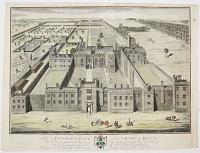
A View of Penshurst Place in the County of Kent. This plate was engraved in the Year 1747, ny Mr George Vertue, for Will.m Perry, Esq. And is now presented to this work by Mrs Elizabeth Perry his Widow, The only remaining Heir of the Noble Family of Sidney, & the Present Owner of this Seat.
[after Benjamin Dry.]
[London: c.1760.]
Coloured engraving with small margins. 440 x 560mm (17¼ x 22"). Binding folds flattened.
A bird's-eye view of the fortified Penshurst Place near Tonbridge in Kent, the ancestral home of the Sidney family (their etched crest is at centre of the inscription). Originally published in 1747 this example was published after William Perry's death in 1757, with the title re-engraved and Dry's inscription dropped.
[Ref: 30839] £290.00
(£348.00 incl.VAT)

Reverendus admodum in Christo Pater Joannes Potter Episcopus Oxoniensis.
M. Dahl pinx. Geo: Vertue Sculp. 1727.
Sold by G; Vertue in Brownlow Street Drury Lane.
Engraving. Sheet: 385 x 275mm (15 x 10¾''). Trimmed within plate.
A portrait of Archbishop of Canterbury John Potter (1674-1747).
[Ref: 48783] £140.00
(£168.00 incl.VAT)
![Legum Decus Patriae Que Is Erat. Legis Series. Inutilis & sine fructu Labor, non est Legis, effectus [Latin inscription at bottom reads; 'Non-useful Labour carried out fruitlessly is not Lawful'].](img-thumbnail/jpegs/4520.jpg)
Legum Decus Patriae Que Is Erat. Legis Series. Inutilis & sine fructu Labor, non est Legis, effectus [Latin inscription at bottom reads; 'Non-useful Labour carried out fruitlessly is not Lawful'].
Sold by Ph. Overton in Fleet Street and J. King in the Poultry Printsellers, Entered in the Hall Book London [n.d. c.1705].
Engraving. Sheet 255 x 365mm. Trimmed to plate. Some foxing spots and surface smudges. Three grease spots lower left corner.
Robert Price [1653 - 1733], MP and Judge. Engraved by George Vertue [1683 - 1756]. Copy from portrait when Price was baron of the Exchequer, engraved and published by Vertue after a painting by Kneller c.1702. He is placed above a symbolic 'Law Tree' flanked by allegorical figures representing justice and law on pedestals. Philip Overton [c.1680 - 1745] was the last of the great Overton dynasty of printsellers and publishers in the eighteenth century. 'ID' collectors' mark in ink on verso.
[Ref: 4520] £110.00
(£132.00 incl.VAT)
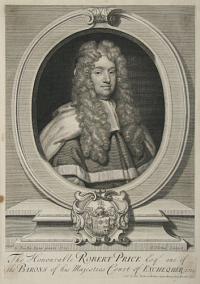
The Honourable Robert Price Esqr. one of the Barons of his Majesties Court of Exchequer 1714.
G: Kneller Eques pinxit 1714. G: Vertue Sculpsit.
Sold by Geo: Vertue in Belton Street Drury Lane London.
Engraving. Mounted on an album page. Image 371 x 262mm. 14½ x 10¼". Cut and laid on sheet. Some glue staining to the corners.
Robert Price (1653-1732) was a British judge and politician. In 1682 Price was appointed Attorney General for South Wales, as well as alderman of the city of Hereford; the following year he became recorder of Radnor; then steward to Catherine of Braganza in 1684; town clerk of Gloucester 1685; and King's Counsel for Ludlow in 1686. Price was removed as Attorney General and from other offices in 1688; he later successfully opposed William III's 1695 grant of lands in Denbighshire to William Bentinck, 1st Earl of Portland, earning the appellation "patriot of his native country". He was appointed a judge in Wales in 1700. Robert Price also served as Member of Parliament for Weobley during this period, resigning the seat in favour of his elder son Thomas in 1702; Queen Anne upon her succession had elevated Price to the House of Lords as a Baron of the Exchequer. In 1726 he became a justice of the Court of Common Pleas. From the Belton House Collection assembled in the 18th Century by the Rt. Hon. John Ld. Brownlow, Baron Charleville, & Viscount Tyrconnel in the Kingdom of Ireland. Ex: Collection of The Hon. C. Lenno
[Ref: 12902] £220.00
(£264.00 incl.VAT)

The Honourable Robert Price Esqr. One of the Barons of his Majesties Court of Exchequer 1714.
G: Kneller Eques pinxit 1714. G: Vertue Sculpsit.
Sold by Geo: Vertue in Belton Street Drury Lane London.
Copper engraving. 381 x 267mm. 15 x 10½". Cut and laid on album sheet.
Robert Price (1653-1733) was a British judge and a politician. In 1682 he was appointed Attorney General for South Wales, before taking later positions as steward to Catherine of Braganza; town clerk of Gloucester and King's Counsel for Ludlow in 1686. He later went onto serve as MP for Weobley before being elevated to the House of Lords as a Baron of the Exchequer following the succession of Queen Anne. In 1726 he became a justice of the Court of Common Pleas. Alexander: 159.
[Ref: 17133] £170.00
(£204.00 incl.VAT)
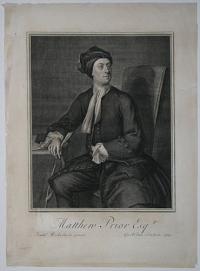
Matthew Prior Esq.r
Jonath:n Richardson pinxit. Geo: Vertue Sculpsit.
1719.
Engraving. Plate 375 x 274mm. 14¾ x 10¾". Tearing and staining around the edges.
Matthew Prior (1664-1721) was an English poet and diplomat. On his father's death, he left school, and was cared for by his uncle, a vintner in Channel Row. Here Lord Dorset found him reading Horace, and set him to translate an ode. He did so well that the earl offered to contribute to the continuation of his education at Westminster. One of his schoolfellows and friends was Charles Montagu, 1st Earl of Halifax. It was to avoid being separated from Montagu and his brother James that Prior accepted, against his patron's wish, a scholarship recently founded at St John's College, Cambridge. He took his B.A. degree in 1686, and two years later became a fellow. In collaboration with Montagu he wrote in 1687 the City Mouse and Country Mouse, in ridicule of John Dryden's The Hind and the Panther. Alexander: 299.
[Ref: 20254] £140.00
(£168.00 incl.VAT)
![[Alonso Quijano at his library.]](img-thumbnail/jpegs/14729.jpg)
[Alonso Quijano at his library.]
I. Vanderbank Invent. et delin: Geo: Vertue Sculpsit 1723.
Engraving. 240 x 190mm. 9½ x 7½". Trimmed and laid and separate sheet.
Alonso Quijano, dressed as an 18th century gentleman, pauses as he reads, to gaze at his family armour, prior to setting out on his adventures as 'Don Quixote'.
[Ref: 14729] £75.00
(£90.00 incl.VAT)

Johannes Radcliffe M.D. Obijt 1o. Nov: MDCCXIV Aetat: 65.
G: Kneller Baront. pinxit 1710. G: Vertue Sculp: 1719.
[n.d. c.1719]
Line engraving. Plate 373 x 272
1650-1714, physician, unorthodox in that he learned by practice and not by books. W: 2417-1.
[Ref: 3609] £130.00
(£156.00 incl.VAT)

Johannes Radcliffe M.D. Obijt 1o. Nov: MDCCXIV Aetat: 65.
G: Kneller Baront. pinxit 1710. G: Vertue Sculp: 1719.
[G. Edwards, c.1757.]
Scarce re-issue by George Edwards of this engraved portrait. Edwards's engraved dedication to physician Thomas Reeve is printed from a separate plate immediately beneath, the inscription indicating that he gave the copper plate to the Royal College of Physicians, and ending "Now first published May 1st 1757./ according to Act of Parliament". Laid paper. Portrait plate 375 x 275mm (14¾ x 10¾"), inscription 55 x 275mm (2¼ x 10¾"). Full margins; heavily restored in top right and centre with repairs to small holes.
Dr John Radcliffe (1652 - 1714), physician and benefactor to University of Oxford; founder of the Radcliffe Library. He is seated, wearing a wig, long coat over his waistcoat, left hand with gloves on his thigh, at the Radcliffe Camera. To the left, a table with folded paper and black jewelled hat; arched alcove in background beyond. After Sir Godfrey Kneller (1646 - 1723). George Edwards (1694 - 1773), better known for his volumes of bird plates, was employed by Sir Hans Sloane in drawing watercolours of animals and birds, and his inscription mentions that "the Plate was the Property of the late Hans Sloane". He was Librarian to the Royal College of Physicians from 1733 and later Engraver to the College. He taught himself to etch. See Wellcome 2417-1 for a first state of the portrait. This version not in BM. Alexander 'Vertue as Engraver' 295.
[Ref: 20890] £220.00
(£264.00 incl.VAT)

Sr. Thomas Rawlinson Kt. and Alderman, Sheriff of the City of London in 1687...
G. Kneller Esq: Baront, pinx: G. Vertue Sculp: 1719.
Rare etching, sheet 480 x 285mm. 19 x 11¼". Trimmed to plate.
Sir Thomas Rawlinson (c.1710 - 1769), Alderman and later Lord Mayor of London. After Sir Godfrey Kneller (1646 - 1723).
[Ref: 16635] £160.00
(£192.00 incl.VAT)

The Right Hon.ble Sr. Robert Raymond Lord Chief Justice of His Maj:ties Court of Kings Bench & one of His Majties. most Hon.ble Privy Council. Ano. Dni. 1724/5.
J. Richardson pinx. Geo: Vertue Sculpsit.
[n.d. c.1725.]
Engraving. 375 x 270mm (14¾ x 10½"). Laid on album sheet. Small margins. Small repaired tears at edges.
Robert Raymond (1673-1733), 1st Baron Raymond PC, British judge. In 1725 he was invested as Privy Counsellor. Raymond, a Tory, was appointed as Lord Chief Justice of the King's Bench on March 2, 1725 until his death. In the House of Lords he tried to stop the House of Commons abandoning Law French and replacing it with English. To Raymond, ending the traditional language might lead to other 'modernisations' such as Welsh for courts in Wales. However his opposition failed and in 1733 the courts were anglicised. Alexander: 447
[Ref: 46997] £260.00
(£312.00 incl.VAT)





![[Montague Bertie, 2nd Earl of Lindsay, and Robert Dormer, 1st Earl of Carnarvon]](img-thumbnail/jpegs/47292.jpg)

![Londinium Antiqua. This Plan shews the ancient extent of the famous cities of London and Westminster as it was near the begining of the Reign of Queen Elizabeth [...]](img-thumbnail/jpegs/35662.jpg)
![[The Chapel of St Thomas on the Bridge] Inside South View of the Under Chappel from East to West,](img-thumbnail/jpegs/61252.jpg)
![[John Evelyn's London plan, drawn after the Fire of London 1666] [&] London Redivivum / Presented by me to his Majesty, a Week after the Conflagration, together with a Discourse now in the Paper Office. JE [John Evelyn]. Another Projection JE. [...]](img-thumbnail/jpegs/45273.jpg)






![[Netherlands] Franciscus Gomarus.](img-thumbnail/jpegs/31125.jpg)



![[The Oxford Almanack for 1742, showing Balliol College]](img-thumbnail/jpegs/43930.jpg)


![[The Oxford Almanack for 1743, showing Lincoln College]](img-thumbnail/jpegs/43931.jpg)
![[Merton College] The Oxford Almanack For the Year of Our Lord God MDCCXXXVII.](img-thumbnail/jpegs/43929.jpg)


![[The Oxford Almanack for 1750, showing New Inn Hall]](img-thumbnail/jpegs/43932.jpg)
![[Oriel College] The Oxford Almanack For the Year of Our Lord God MDCCXXVI](img-thumbnail/jpegs/41666.jpg)












![Legum Decus Patriae Que Is Erat. Legis Series. Inutilis & sine fructu Labor, non est Legis, effectus [Latin inscription at bottom reads; 'Non-useful Labour carried out fruitlessly is not Lawful'].](img-thumbnail/jpegs/4520.jpg)



![[Alonso Quijano at his library.]](img-thumbnail/jpegs/14729.jpg)



